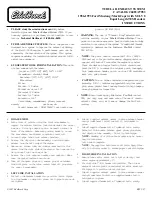
(highway or sandy soil road), road
conditions (wet, dry, frozen), tyre
tread,
brake
condition,
vehicle
weight and brake force.
Avoid
depressing
brake
pedal
suddenly at unnecessary time. Some
drivers drive irregularly, such as
depressing the brake pedal shortly
after depressing the acceleration
pedal, instead of keeping pace with
the vehicle flow. This is an incorrect
practice. The brake cannot get
cooled down in continual emergency
brakes.
Frequent
depressing
of
brake irregularly may speed up the
wear of the brake. Keeping pace
with vehicle flow with a certain
distance
may
greatly
reduce
unnecessary brakes, which can
improve brake effect and lengthen
the service life of the brake.
158
Turning under emergent conditions
Sometimes turning is more effective
than brake. For example, you climb
up a slope to find that a big truck is
parking in your lane, or another
vehicle comes in from somewhere,
or a child rushes out from parking
vehicles and stops just ahead of you,
you may use brake to evade these
obstacles, provided that you can stop
your vehicle in time. Sometimes you
are unable to achieve it as there is
not sufficient space. At this time you
need to take evading measures to
pass around the obstacles.
Under these emergent situations,
your vehicle will present its preemin
-ent performance. First depress
brake pedal. Refer to Brake in this
chapter.
You had better decelerate your
vehicle if a collision is likely to occur.
Then pass around the obstacle by
turning to the left or right according
to existing space.
High concentration and decision are
required
under
this
emergent
situation. If you hold the steering
wheel at 9 o'clock and 3 o'clock
positions according to the recomm
-ended method, you can turn the
steering wheel quickly by 180
degrees without moving a hand.
You must do it quickly and turn
swiftly, and bring the wheels to
normal position after evading the
obstacle.
In fact, be sure to drive cautiously
with the safety belt fastened since
such emergent situation may occur
anytime.
Summary of Contents for A-CLASS
Page 4: ...4...
Page 6: ...6...
Page 14: ...17 16 14 15 13 12 14 11 Overview of Instrument Panel...
Page 17: ...17 B 1 Speed meter 2 Water temperature gauge 3 Odometer 4 Fuel gauge 5 Tachometer...
Page 176: ...176 Memorandum...
















































